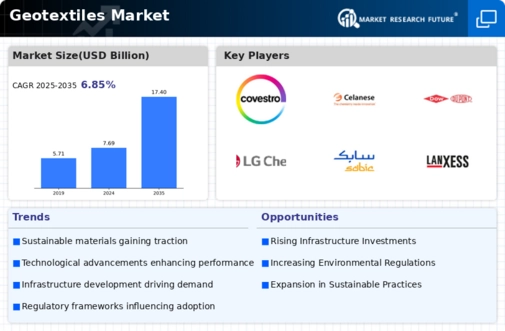Urbanization Trends
Rapid urbanization across the globe is a crucial factor driving the Global Geotextiles Market Industry. As cities expand, the demand for effective land management solutions increases, leading to a greater reliance on geotextiles for urban infrastructure projects. The need for effective drainage systems, road construction, and land reclamation in urban areas necessitates the use of geotextiles to enhance soil stability and prevent erosion. This trend is particularly evident in developing countries, where urban populations are surging. Consequently, the market is expected to grow significantly, with projections indicating a market value of 7.69 USD Billion in 2024, reflecting the impact of urbanization on geotextile demand.
Environmental Regulations
Stringent environmental regulations are shaping the Global Geotextiles Market Industry by promoting sustainable practices in construction and land management. Governments worldwide are implementing policies that require the use of geotextiles to mitigate environmental impacts, such as soil erosion and sedimentation. For example, regulations in the European Union mandate the use of geotextiles in various civil engineering projects to protect natural resources. This regulatory landscape not only drives demand for geotextiles but also encourages innovation in product development, as manufacturers strive to meet these standards. As a result, the market is poised for growth, with a projected CAGR of 7.73% from 2025 to 2035.
Market Growth Projections
The Global Geotextiles Market Industry is poised for substantial growth, with projections indicating a market value of 17.4 USD Billion by 2035. This growth trajectory is underpinned by various factors, including increased infrastructure investments, rising environmental awareness, and technological advancements. The anticipated CAGR of 7.73% from 2025 to 2035 suggests a robust expansion phase for the industry. As stakeholders across sectors recognize the benefits of geotextiles in enhancing sustainability and performance, the market is likely to attract further investments and innovations, solidifying its position in the global materials landscape.
Infrastructure Development
The ongoing expansion of infrastructure projects globally is a primary driver for the Global Geotextiles Market Industry. Governments and private sectors are increasingly investing in roads, bridges, and railways, necessitating the use of geotextiles for soil stabilization and erosion control. For instance, the construction of new highways in emerging economies has led to a heightened demand for geotextiles, which are essential for enhancing the durability and longevity of these structures. This trend is expected to contribute to the market's growth, with projections indicating a market value of 7.69 USD Billion in 2024, reflecting the critical role of geotextiles in modern infrastructure development.
Technological Advancements
Technological advancements in the production and application of geotextiles are significantly influencing the Global Geotextiles Market Industry. Innovations such as the development of biodegradable geotextiles and advanced manufacturing techniques are enhancing product performance and sustainability. For example, the introduction of geotextiles that incorporate nanotechnology has improved their strength and durability, making them more effective in various applications. These advancements not only meet the increasing demand for high-performance materials but also align with global sustainability goals. As a result, the market is likely to experience robust growth, driven by these technological innovations that cater to diverse industry needs.
Rising Awareness of Soil Erosion
Increasing awareness regarding soil erosion and its detrimental effects on agriculture and infrastructure is propelling the Global Geotextiles Market Industry. Farmers and landowners are recognizing the importance of geotextiles in preventing soil loss and enhancing crop yields. For instance, the adoption of geotextiles in agricultural practices has been shown to improve soil structure and moisture retention, leading to better harvests. This awareness is particularly pronounced in regions prone to erosion, such as coastal and hilly areas. As the agricultural sector continues to embrace sustainable practices, the demand for geotextiles is expected to rise, contributing to the market's anticipated growth to 17.4 USD Billion by 2035.

















